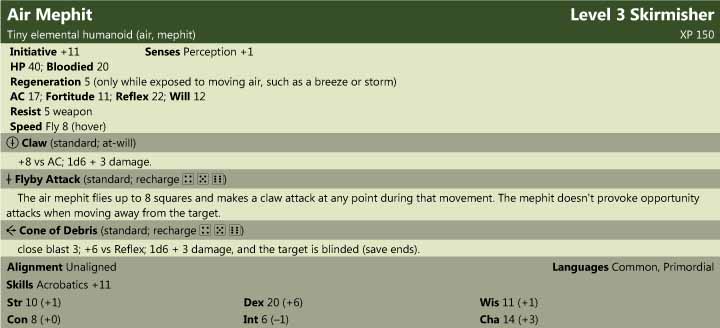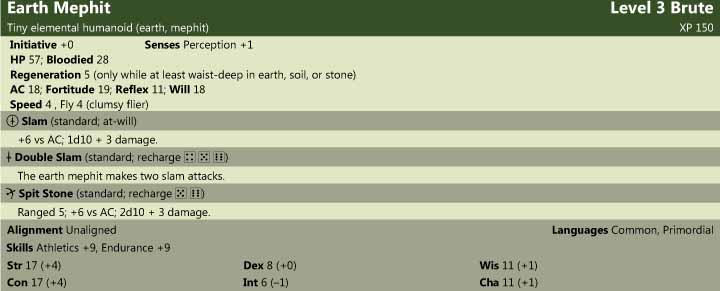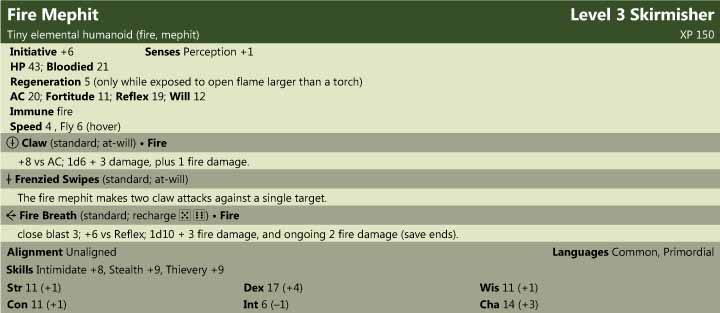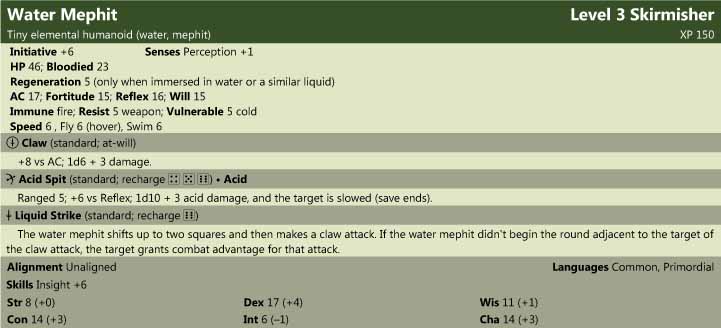Mischievous Mephits
Hello everyone. Today’s Foursaken Feature is a beloved monster from days gone by which hasn’t quite gotten around to updating itself to the new edition (they’re notoriously lazy). Actually, it’s four different monsters. Well, “monsters” may be a stretch… most wizards would refer to them as “pests.” Or something not quite as nice. But the thought’s the same. So, what are these mysterious monsters? Mephits, of course.
For those of you not familiar with mephits, they are imp-like creatures with close ties to the various elements. They are humanoid, about the size of a large cat, and typically have large, bat-like wings. As a rule, they are mischievous and more trouble than they are worth, but for some reason wizards keep summoning them (or creating them—it isn’t terribly clear, see below) anyway. Their personalities and abilities vary greatly depending on the kind of mephit in question: there are 16 in all, one for each of the elements, the para-elements, and the quasi-elements. Of course, concepts such as para- and quasi-elements are of little value to those who aren’t planar metaphysicists, and as far as anyone who’s met a mephit is concerned there’s only one kind: the annoying kind.
For some reason, mephits remain popular servants amongst wizards and other arcane spellcasters. Though the ritual to acquire a mephit servant is admittedly simple enough, one would think that the mischievous, lazy, and quite often rude creatures wouldn’t be worth the trouble. It is unclear whether mephits are created or summoned in this ritual: their physiology makes it unlikely in most cases that they are actually native to the elemental chaos, and it is unclear whether or not the mephits found there are natives or have travelled there after escaping their wizard masters. The popular theory is that the ritual which makes them pulls the spirit of a lesser elemental or archon from the chaos and binds them into mortal form.
Whatever their origin, it’s undeniable that mephits have a bit of the elemental chaos in them. Their close ties to the elements are one example, but so is their seemingly inherent need to stir up trouble and cause chaos in the world around them. It has become common for wizards to send messages to their rivals via mephits—curiously, the message is the mephit itself, as different types of mephits have taken on different meanings. And, of course, the unlucky recipient then needs to find something to do with the unruly message, which serves as a sort of “gift.”
Below are the four most basic types of mephits: air, earth, fire, and water.
Air Mephits:
Air mephits are unlike most mephits in that they don’t possess wings. Instead, from the waist down they are nothing more than a cloudy whirlwind, which allows them to maneuver through the air with great speed and maneuverability. Their skin is pearly-white from the waist-up, and their eyes are often a very bright, sky blue.
As one might expect, air mephits are more than a bit flighty in personality, and few things can hold their attention for long. They are known for wandering away from their duties at the slightest provocation, often never to return (usually to the relief of their master). Highly excitable, they are among the more tolerable mephits, as long as you never find yourself depending on them to not run off after adventure, a mysterious-looking figure, a tantalizing treasure, or just a ball of string.
An air mephit is usually sent when the sender feels insulted that the recipient isn’t taking him seriously enough, and usually carries a subtle undertone of warning. As a servant, air mephits are primarily used as simple air conditioners, keeping a room from getting too stuffy or hot.

Earth Mephits:
Earth mephits are made at least partially of rock, and are far heavier than most other mephits. Their wings, which are made entirely of stone, do not move, and are not used to keep the mephit aloft (how these mephits fly is a topic of much debate amongst those few scholars willing to devote any time to something as trivial as mephit physiology). They are very clumsy when compared to their cousins, and typically smell strongly of dirt.
Earth mephits are incredibly stubborn and single-minded. The subject typically on their minds is the accumulation of wealth, especially coins and gems. This is due in part to a natural greed inherent to earth mephits, but also because they tend to eat the stuff, not for sustenance, but rather for pleasure (those who know earth mephits are baffled as to how they can enjoy eating coins but turn their nose up at fine cuisine, calling it “tasteless”).
An earth mephit is sent to indicate that the sender hasn’t changed his mind. Typically this is in response to another request, and is in effect a very firm “no,” but it can also be sent as an indication that the sender has weathered a recent attack or similar, and isn’t backing down. As a servant, earth mephits are among the best for performing simple chores, because as long as they receive a steady (but not necessarily substantial) stream of currency they will be unfailingly and single-mindedly obedient.

Fire Mephits:
Fire mephits have red skin and cruel, wicked faces which makes it easy to mistake them for imps (the major difference in appearance is the imp’s poison stinger). Though not made of fire, fire mephits do radiate heat, and touching them is enough to cause 1 point of fire damage. Some fire mephits try to play up the resemblance by wearing a fake goatee, moustache, and/or horns, attempting to fool the gullible into believing they are powerful devils. This rarely ends well for the fire mephit, especially if they ever encounter an actual devil. Fire mephits are possibly the most malicious of all mephits, and take great pleasure in the suffering of others.
A fire mephit is sent to indicate displeasure with the recipient, and the number of fire mephits sent is used to gauge just how angry the sender is. The current record is 4,385 fire mephits sent to Alaundo Calissar, who ran away with the sender’s daughter. The ensuing brushfire took four weeks to put out. As servants, fire mephits are used as a cheap alternative to actual fires, and can be found performing tasks ranging from heating ovens to lighting pipes.

Water Mephits:
These scaly, blue-green creatures have webbing between their toes, fingers, and just about any other place it could conceivably go. They have bulging fish eyes and smell strongly of dead fish, much to the displeasure of those who summon them. Though they are normally fully solid, they can turn their body (in part or in whole) to liquid at will, allowing most weapons to pass right through them. Naturally resistant to fire, they are particularly vulnerable to cold attacks, which have a tendency to freeze them solid.
Everything is a joke to a water mephit, and, despite what the mephits may think of themselves, most fail to find much humor in the mephits’ jokes, which tend to be highly lacking in tact or class. Nevertheless, the mephits are quite cheery, and never let little things like invading armies of demons get them down.
A water mephit is typically sent after the sender survives (or avoids) some plot or scheme of the recipient’s. Though it is intended to imply a certain amount of disdain for the attack in question, it is far less smug or condescending than some other types of mephits, and may in fact be an admission of a close call. On the other hand, it could also be an attempt to lull the recipient into a false sense of security, ensuring their next attack will be premature. As servants, water mephits are typically stationed in places where fires are likely to break out, though some are maintained as custodians and gardeners of larger aquariums.

If you enjoyed these mephits (or hated them) be sure to send an e-mail and let us know (please don’t send any via mephit!).


